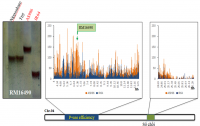|
Vuong nam trung. 2011. Identification of apparent digestibility energy and amino acid requirements of yorkshire pig at large scale production
Thứ năm, 02-02-2012 | 08:00:07
|
|
PhD Thesis ABSTRACT The study aims at determining the apparent digestibility energy and amino acid in Yorkshire pig at different stages such as gilt, pregnant sow, lactating sow, young boar and working boar. In the digestibility trial, 8 intact male Yorkshires (35 kg/head) were randomly treated into 8 different diets. The total waste collection method and the difference test were statistically applied to pinpoint the apparent digestibility coefficient (ADC). The digestible energy values were noticed the best in full fat soybean treatment (3556 kcal DE /kg) siginicantly higher than rice bran, wheat bran, soybean meal and fish meal, (3260; 3212; 3242; 3217 kcal DE /kg, respectively). However, it was not significantly different from broken rice and corn (3382; 3348 kcal DE /kg). ADC of both protein and lysine were the best in the treatments of fish meal and soybean meal (85.03; 81.29 % as compared to 85.41; 83.57%, respectively). They were significantly obtained higher than rice bran, broken rice, corn and wheat bran (69.31; 69.03; 75.85; 68.56% and 71.17; 73.42; 68.26; 68.72%), but not different from soybean meal (80.30; 82.91%). Meanwhile, ADC of sulfur amino acids was the best in soybean meal (83.95%) and the worse in wheat bran, corn (68.23; 67.77%). To determine the daily requirement of energy and amino acid in gilts, a total of 96 Yorkshire gilts (70 days old) were divided into four treatments as T1: ad libitum feeding in periods 1 and 2; T2: ad libitum in period 1 and restricted in period 2; T3: restricted in period 1 and ad libitum in period 2: T4: restricted in periods 1 and 2. Feed allowance of the restrictedly fed animals was about 85% as compared to ad libitum feeding. The total of 48 blood samples at 90; 150; 180 day old and day 0; day 3; day 10 as from oestrus were collected. Feed allowance of ad libitum in period 1 and restricted in period 2 saved 12.5% feed consumption and exhibited no effect on oestradiol and progesterone levels in serum as well as productivity in the sow. To determine the daily of energy and amino acid requirement in pregnant sow, 72 dry Yorkshire sows (3 groups, 24 sows each groups based on body score) were randomly treated into four treatments represented four nutrient levels. The results showed that the best daily intake of digestible energy and amino acid in the samples of thin, medium and fat pregnant sows were 8160-12.0; 6800-10.0 and 5400 kcal DE-8.0 g digestible lysine for the first 84 day of pregnant period and 10200-15.0; 8500-12.5 and 6800 kcal DE-10.0 g digestible lysine for the last 30 day of pregnant period. To determine the requirement of energy and amino acid in lactating sow, a total of 24 lactating Yorkshire sows were randomly divided into four treatments as: T1: 3000-0.65; T2: 3150-0.75; T3: 3300-0.85; T4: 3450 kcal DE/kg feed -0,95% digestible lysine. All sows were fed ad libitum. The results showed that the best nutrition density in diet for lactating Yorkshire sow should be 3300 kcal DE /kg feed, 0.85% digestible lysine. In the young boar trial, a total of 18 intact male Yorkshire boars (90 days old) were divided into three treatments as T1: 100%; T2: 90%; T3: 80% nutrient level of NRC recommendation. All boars were fed ad libitum up to 150 day old and then restricted at 2 kg /head/day. The total of 18 serum samples were also collected at 90 and 150 day old. The results showed that decrease of 10% nutrient density as compared to NRC recommendation did not affect testosterone level in serum as well as productivity in the young boars. In order to determine protein and amino acid requirement of working boar with different frequencies of collection, 36 working Yorkshire boars at the age of 18-24 month old were treated into 12 treatments with two-factorial design including nutrition density in diet (4 levels) and semen collection frequency (3 levels). Feed adaptation time was 6 weeks and all boars were fed 2 kg feed /head/day. The results showed that the best diet of working Yorkshire boar with 1; 2 and 3 times of collection per week were obtained as 12.5%-0.65%; 13.5%-0.75% and 14.5%-0.85%, respectively for digestible protein and digestible amino acid. |
|
|
|
[ Tin tức liên quan ]___________________________________________________
|


 Curently online :
Curently online :
 Total visitors :
Total visitors :
